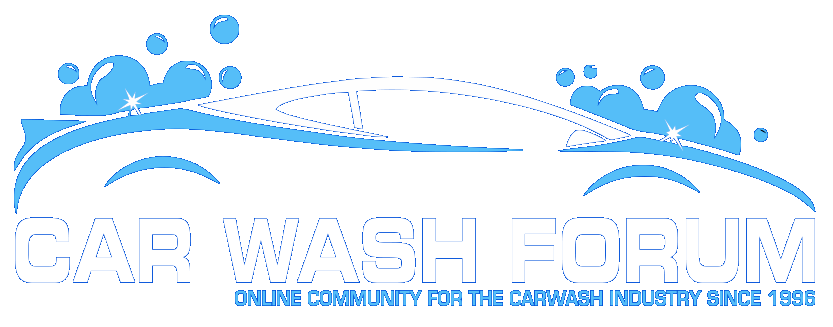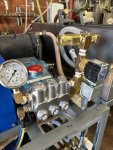Car Wash Forum
You are using an out of date browser. It may not display this or other websites correctly.
You should upgrade or use an alternative browser.
You should upgrade or use an alternative browser.
Hot water heater?
- Thread starter goodingcarwash
- Start date
goodingcarwash
Member
I'm going to use relays also, just saying multiplexer to explain what I meant without confusion. Thanks tho.I would keep the solenoids on the air lines to the flojets...They are basically a fail safe in case a chemical solenoid fails open and drains a bucket of chemicals when you're not there! I use relays instead of a multiplexer to control the air solenoids...

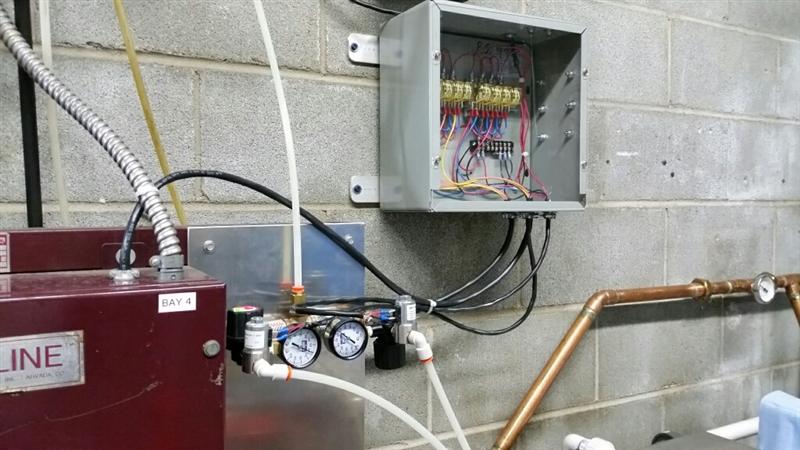
goodingcarwash
Member
So my previous stand used Zero pressure regulators for hp soap and wax injection and solenoid valves for hot and cold water. My new stand used a stock tank for pump supply water and just sucked the soap in. I want to keep hw for soap and wax, and possibly even a adding hp hw option. I have yet to grab my ro system and figure out how the presoak works but will there be any issues running thease Zero pressure regulators on my new stand with pressure inlets? How dose spot free rinse and presoak normally work. Is it hp or is that what the extra pump is for?
Attachments
2Biz
Thread Killer!
I don't know if this helps, but it is how I have my pumpstand plumbed....Hot and Cold gravity tanks feed "Erie" 2 way motorized valves with 1/2" poly hose to each pump. I use heated water for soap and wax, easy to wire....Heated water plumbed to the NO inlet of the valves so if they fail, they fail NO (spring loaded return) . For me, the benefit of using the Erie Motorized valves, IF a valve fails, there is no way for them to starve your pumps....BTW, all my Erie valves are about 10 years old and still working fine. Basically a spinoff from the OEM but simplified greatly! I built a spare assembly for Drop in when I redesigned the original Mark VII stand....Haven't needed it so far! The 1/4" Wye is for soap and wax inlets. The 1/2" barb on the left is for pump bypass. The (2) Dwyer flow meters are for soap and wax so I can get all bays set up exactly the same and to help with trouble shooting.
Using 1/2" poly hose gives just enough vacuum to where you don't have to "Choke" water flow to the pumps for soap and wax to draw into the pumps. IMHO (And CantBreak80"s) if you use TF, put the PS on the foam gun. Solves so many issues! (Better Flow and the amount of CV's needed which is none!) SFR is plumbed using nylon hose to above each bay, CV needed at the manifold above the bay. My SFR uses a booster pump regulated to 150psi...
So far, the KISS method works for me. It is rare that I have to work on the pumpstand and it is modified now to where I CAN work on it if needed. The OLD OEM Mark VII was and would have been a nightmare to work on!

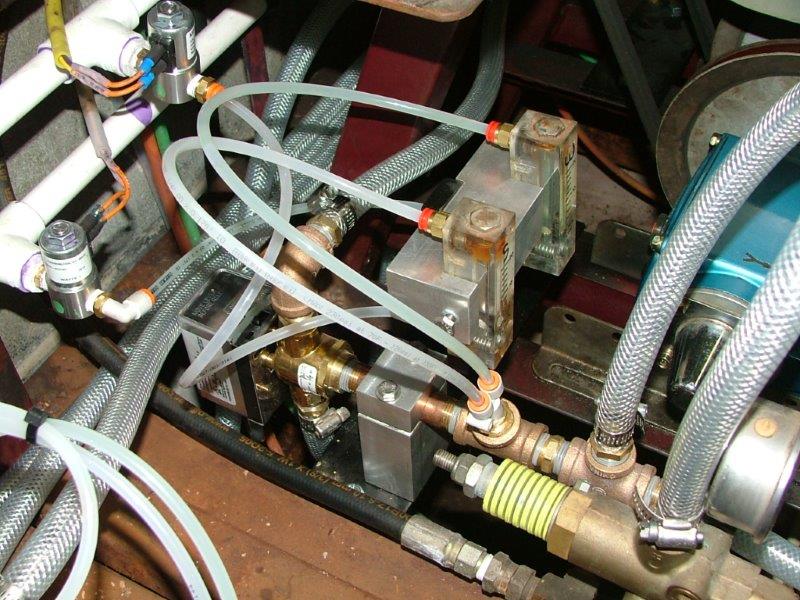

Using 1/2" poly hose gives just enough vacuum to where you don't have to "Choke" water flow to the pumps for soap and wax to draw into the pumps. IMHO (And CantBreak80"s) if you use TF, put the PS on the foam gun. Solves so many issues! (Better Flow and the amount of CV's needed which is none!) SFR is plumbed using nylon hose to above each bay, CV needed at the manifold above the bay. My SFR uses a booster pump regulated to 150psi...
So far, the KISS method works for me. It is rare that I have to work on the pumpstand and it is modified now to where I CAN work on it if needed. The OLD OEM Mark VII was and would have been a nightmare to work on!



Last edited:
cantbreak80
Maybe I need new clubs
That era of Hydrospay equipment utilized the booster pump for circulating heated pre-soak to the roof-top plumbing trough. Each bay’s PS solenoid was teed in the circulating loop, above the bay. The concept is to use the heated PS to keep the trough warm. It’s a pain-in-the-neck to maintain/service the solenoids & CHECK VALVES.
Similar to 2Biz's, our installations feature FloJet pumps for all low-pressure products (PS, Tire, Bug Juice, MagChloride, Tri-foam) all delivered thru a foam gun. NO CHECK VALVES living in the roof trough!
For simplicity, we provide warm water only to the HP pumps…yes, warm soap, wax, and rinse. Everything is gravity fed with 1/2" hoses to the pump inlets. NO CHECK VALVES, Zero Pressure Regulators, throttling valves, or solenoid valves required! One water tank, one soap tank, and one wax tank.
For SFR, I’m a firm believer in medium pressure delivery…400-500psi. This is accomplished with a high-volume Cat 390/5hp motor. Or, by using the existing HP pumps equipped with HP bypass solenoid valves and regulators. Both systems use the existing HP plumbing to the bays. (the latter requires NO CHECK VALVES!)
Here’s a view of our typical pump plumbing…simple and easy to service!
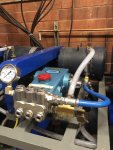
Here’s a look at the same pump equipped with dual pressure controls for 400-500psi SFR delivery. This modification replaced a wimpy multi-stage repressurization pump system that customers rarely used.
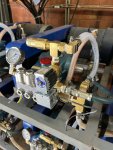
Similar to 2Biz's, our installations feature FloJet pumps for all low-pressure products (PS, Tire, Bug Juice, MagChloride, Tri-foam) all delivered thru a foam gun. NO CHECK VALVES living in the roof trough!
For simplicity, we provide warm water only to the HP pumps…yes, warm soap, wax, and rinse. Everything is gravity fed with 1/2" hoses to the pump inlets. NO CHECK VALVES, Zero Pressure Regulators, throttling valves, or solenoid valves required! One water tank, one soap tank, and one wax tank.
For SFR, I’m a firm believer in medium pressure delivery…400-500psi. This is accomplished with a high-volume Cat 390/5hp motor. Or, by using the existing HP pumps equipped with HP bypass solenoid valves and regulators. Both systems use the existing HP plumbing to the bays. (the latter requires NO CHECK VALVES!)
Here’s a view of our typical pump plumbing…simple and easy to service!

Here’s a look at the same pump equipped with dual pressure controls for 400-500psi SFR delivery. This modification replaced a wimpy multi-stage repressurization pump system that customers rarely used.

goodingcarwash
Member
So you supply soap and wax straight to the pump? Or y into your water supply?That era of Hydrospay equipment utilized the booster pump for circulating heated pre-soak to the roof-top plumbing trough. Each bay’s PS solenoid was teed in the circulating loop, above the bay. The concept is to use the heated PS to keep the trough warm. It’s a pain-in-the-neck to maintain/service the solenoids & CHECK VALVES.
Similar to 2Biz's, our installations feature FloJet pumps for all low-pressure products (PS, Tire, Bug Juice, MagChloride, Tri-foam) all delivered thru a foam gun. NO CHECK VALVES living in the roof trough!
For simplicity, we provide warm water only to the HP pumps…yes, warm soap, wax, and rinse. Everything is gravity fed with 1/2" hoses to the pump inlets. NO CHECK VALVES, Zero Pressure Regulators, throttling valves, or solenoid valves required! One water tank, one soap tank, and one wax tank.
For SFR, I’m a firm believer in medium pressure delivery…400-500psi. This is accomplished with a high-volume Cat 390/5hp motor. Or, by using the existing HP pumps equipped with HP bypass solenoid valves and regulators. Both systems use the existing HP plumbing to the bays. (the latter requires NO CHECK VALVES!)
Here’s a view of our typical pump plumbing…simple and easy to service!
View attachment 9790
Here’s a look at the same pump equipped with dual pressure controls for 400-500psi SFR delivery. This modification replaced a wimpy multi-stage repressurization pump system that customers rarely used.
View attachment 9791
cantbreak80
Maybe I need new clubs
Coleman's systems are a single hot water storage tank with a 3/4" check valve and line feeding the pump. Teed into the pump feed line is a 1/2" solenoid that has pressurized water. There is a regulator on the rinse manifold to keep the inlet pressure down. I think I keep mine at 20 psi. When the rinse is selected the pressurized rinse manifold opens and "overrides" the hot water feed. No zero pressure regulator needed. The big disadvantage is the hot water tank cools off if you don't either recirculate it or use a cartridge heater. If you don't have either of these the firt customer of the day gets less than hot water.
I have a Carolina pride system that uses just a single tank, all HP functions are hot. It's surprisingly inexpensive to do all hot water. My gas bill is usually around $250 per month. I do run my water more warm than hot-probably 105-110.
Presoak and Spot Free are best to be run using their own pumps and plumbing and teed into the bay manifold at the boom. Some companies use valves and pump RO through the high pressure lines but there is a potentially longer delay than desired. Coleman does their presoak through high pressure lines and it's terrible, resulting in long changeover times and weak presoak that doesn't clean well.
The carolina pride system has essentially that because they heat and circulate their presoak. It was set up to run continuously 24/7 but I put a MX-10 on it so it now only runs when a meter is running. I have a toggle switch where I can turn it on and will do it when we expect a hard freeze. I've had very few problems with it.
I have a Carolina pride system that uses just a single tank, all HP functions are hot. It's surprisingly inexpensive to do all hot water. My gas bill is usually around $250 per month. I do run my water more warm than hot-probably 105-110.
Presoak and Spot Free are best to be run using their own pumps and plumbing and teed into the bay manifold at the boom. Some companies use valves and pump RO through the high pressure lines but there is a potentially longer delay than desired. Coleman does their presoak through high pressure lines and it's terrible, resulting in long changeover times and weak presoak that doesn't clean well.
Sooo many ways to skin a cat! First time I've ever heard of using circulated PS to heat the trough! I can only imagine the problems that created!
The carolina pride system has essentially that because they heat and circulate their presoak. It was set up to run continuously 24/7 but I put a MX-10 on it so it now only runs when a meter is running. I have a toggle switch where I can turn it on and will do it when we expect a hard freeze. I've had very few problems with it.
My wash had a large natural gas boiler with holding tank with recirculating pump when I purchased. I am in upstate SC and we only have about 20 nights a year it gets below freezing. After the first winter I eliminated that big boiler and the gas bill. The weep system works great. I have never missed the lack of hot water and the space it opened up is great.
goodingcarwash
Member
I'll keep my zero pressure, it seams to work well and I don't have to worry about inconsistent soap or cavitation. I am liking the solenoid on the second regulator for for sfr. In an attempt to cut cost and labor temporarily could I run presoak the same way. Run a pretty aggressive mix at the hydrominer and plum it in like hp soap only set the second regulator to say 500psi or so? I assume your not running fb then? I'm planning on adding a scrubber handle for tires, a foam cannon for tripple foam ps ect, air shammy and im worried about congesting my already small bays. I also wonder if wax wouldn't be better delivered with a lower pressure.Soap & wax are plumbed to the pump's left side inlet with a push-to-connect "Y" fitting.
Or is there a better way of going about it. If that 45psi pump is still operational maybe that would be a good way to pump presoak to the bays. I will have an unused pump spot on my stand, I'm leaning away from running a strong presoak though a sureflow. And I like how simple the hp soap and wax setup is. Maybe I'm just overthinking everything. Its nice reading how everyone dose it and the pros/cons of each.
goodingcarwash
Member
Also what is the old school way of running tire cleaner an presoak through the hp wand. Is it just pumped into the boom manifold with a hp check valve?
2Biz
Thread Killer!
The "Old School" answer would be yes....But using a typical 2506 nozzle rated for 1200psi pump pressure, running presoak off a flojet or possibly a procon pump will not give the best flow rates. You could use a second regulator and solenoid, but that is a lot to install when it can be done a lot easier!..."New School"...You might try plumbing both PS and TC to your foam gun using either a flojet or procon. I use a FJ...Plenty of volumn at 60psi air pressure when running through a ~5050 nozzle. Flojets tend to last me about 5 years... You could do it without the use of CV's because the nozzle size on a foam gun is much bigger and less restrictive. You won't get backfeed on multiple lines plumbed to the same manifold like you would if using a HP manifold. Flow will take the path of least resistance.Also what is the old school way of running tire cleaner an presoak through the hp wand. Is it just pumped into the boom manifold with a hp check valve?
CantBreak80 mentioned all this in his post above...I took his advice Years ago and have never regretted a single second!
I wouldn't say your comment is 100% true about not having to worry....Con...What if the zero pressure regulator fails and starves a pump or fails to where the customer doesn't get soap or wax. Soap and wax are delivered based on vacuum of the inlet water pressure? Pro...My system uses Erie 2 way control valves for Hot and Cold and uses both hot and cold gravity tanks. The way the Erie valves work is there is absolutlely no way it can starve a pump, even if the valve fails to operate. IF the valve fails, it will fail in the NC state (Not Water Flowing) which gives the customer Hot Water for all cycles. Its easy to know if a valve fails, although haven't experienced it yet! LOL. The vacuum remains the same whether the valve is open to hot or open to cold so soap and wax always draw at the same rate. Picture hot water coming in from the left of the valve, cold coming in the right with a motorized flapper between both ports. There is no way the flapper can starve both ports at the same time. I replaced all the Erie valves over 10 years ago when I over-hauled/modified the pump stand. I haven't touched the flow rates (needle valves) of either soap or wax since...
Last edited:
goodingcarwash
Member
So your saying I should just jump on a foam cannon? I'm thinking of just dropping a coil hose from the roof until I can figure out a boom or something? I've seen it done but usually with a taller roof.
2Biz
Thread Killer!
I'm not saying you should do it one way or another. Just giving you different options and which one I went with or ended up with. You will have to decide that on your own! Where are you located? Will you have to winterize the foam gun? All things to think about. Why I asked where you live. I had issues using a coiled hose. I think the hose was about 50' coiled up...Since I live in Southern Ohio, it can get quite cold. I tried using methanol TF at first but was problematic with spuratic freezing and the hose was always knotted up. So I switched to a straight 3/8 Goodyear Black Air hose. This seemed to work better with the hose length now at about 15'. Then a year or so later, again at the advice of CantBreak80, I installed a blowdown/washerfluid PLC (Or PLR) system that keeps all LP winterized below 32°. This has worked about as flawless as you can get, at least down to -5°...I believe at that time I put PS on the Foam gun too. Night and day difference than trying to push PS through a high pressure nozzle. No LP CV's in the attic is a big bonus...BTW, I just use dual wall mount booms for FB and foam gun.
So your saying I should just jump on a foam cannon? I'm thinking of just dropping a coil hose from the roof until I can figure out a boom or something? I've seen it done but usually with a taller roof.
Somebody makes a wall mount you can use. It's basically an stainless 3/8" union with a mounting brcket welded on. I used them at a rehab I did a few years ago.
goodingcarwash
Member
Well I ordered some coil hoses and foam cannons, it gets quite cold here in Central Idaho. I'll probably upgrade my wall boom fb to a dual boom at some point. I did install a Dixmor weep although I haven't connected the fb. I really don't get alot of traffic when its below freezing, and the few I get don't use the foam brush. It hasn't really froze up except the outside bay with a 50 footish hose that very rarely gets used. I'll probably delete the fb with the fc. I have a 30' hose on an air reel and its kinda setup for trailers and tow trucks ect. The fb take a few minutes to start flowing. I had stickers up asking muddy rigs to use the outside bay and many did until the cold caused the outside bay extra problems. Although next cold spell I plan on blowing down and shutting down as the ice was dangerous and usage was almost zero. A couple cold nights is one thing. I may look into a automated blow down in the future.I'm not saying you should do it one way or another. Just giving you different options and which one I went with or ended up with. You will have to decide that on your own! Where are you located? Will you have to winterize the foam gun? All things to think about. Why I asked where you live. I had issues using a coiled hose. I think the hose was about 50' coiled up...Since I live in Southern Ohio, it can get quite cold. I tried using methanol TF at first but was problematic with spuratic freezing and the hose was always knotted up. So I switched to a straight 3/8 Goodyear Black Air hose. This seemed to work better with the hose length now at about 15'. Then a year or so later, again at the advice of CantBreak80, I installed a blowdown/washerfluid PLC (Or PLR) system that keeps all LP winterized below 32°. This has worked about as flawless as you can get, at least down to -5°...I believe at that time I put PS on the Foam gun too. Night and day difference than trying to push PS through a high pressure nozzle. No LP CV's in the attic is a big bonus...BTW, I just use dual wall mount booms for FB and foam gun.
cantbreak80
Maybe I need new clubs
Over the years we’ve converted most of our customers to low pressure foaming guns for Pre-soak, Tire, Bug, Desalt, etc.
Low pressure products, delivered thru a separate foam gun, has many benefits:
Water weep doesn’t always work well on foam guns due to the large nozzles…in fact, it will likely reduce weep volume to the high pressure guns and then, you’ll regret the conversion.
Air-Blow-Out will work as long as there are no hose loops below the stored gun holders. Residual moisture will almost always collect and freeze in the loop.
Adding methanol to the blended product will work but your Fire Marshal won’t be happy with all that flammable material in the equipment room. Sadly, nobody seems to manufacture “winter formula” Pre-Soak or Tire Cleaner.
A PLC-based freeze protection control system is expensive to build and involves considerable wiring modifications.
Some basic bay parts from KR
Hose mount
Foam Gun
Foam gun nozzle
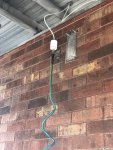



Low pressure products, delivered thru a separate foam gun, has many benefits:
- Much quicker product delivery to the gun
- Much better show and coverage for the customer…you can’t get quality foam thru a high-pressure nozzle.
- NO CHECK VALVES required when properly installed.
Water weep doesn’t always work well on foam guns due to the large nozzles…in fact, it will likely reduce weep volume to the high pressure guns and then, you’ll regret the conversion.
Air-Blow-Out will work as long as there are no hose loops below the stored gun holders. Residual moisture will almost always collect and freeze in the loop.
Adding methanol to the blended product will work but your Fire Marshal won’t be happy with all that flammable material in the equipment room. Sadly, nobody seems to manufacture “winter formula” Pre-Soak or Tire Cleaner.
A PLC-based freeze protection control system is expensive to build and involves considerable wiring modifications.
Some basic bay parts from KR
Hose mount
Foam Gun
Foam gun nozzle




tdlconceptsllc
Well-known member
Somebody makes a wall mount you can use. It's basically an stainless 3/8" union with a mounting brcket welded on. I used them at a rehab I did a few years ago.
Etowah Valley does make this bracket indeed
2Biz
Thread Killer!
Over the years we’ve converted most of our customers to low pressure foaming guns for Pre-soak, Tire, Bug, Desalt, etc.
Low pressure products, delivered thru a separate foam gun, has many benefits:
Caveat…If you’re in a cold weather location you’ll need a freeze protection strategy.
- Much quicker product delivery to the gun
- Much better show and coverage for the customer…you can’t get quality foam thru a high-pressure nozzle.
- NO CHECK VALVES required when properly installed.
Water weep doesn’t always work well on foam guns due to the large nozzles…in fact, it will likely reduce weep volume to the high pressure guns and then, you’ll regret the conversion.
Air-Blow-Out will work as long as there are no hose loops below the stored gun holders. Residual moisture will almost always collect and freeze in the loop.
Adding methanol to the blended product will work but your Fire Marshal won’t be happy with all that flammable material in the equipment room. Sadly, nobody seems to manufacture “winter formula” Pre-Soak or Tire Cleaner.
A PLC-based freeze protection control system is expensive to build and involves considerable wiring modifications.
Some basic bay parts from KR
Hose mount
Foam Gun
Foam gun nozzle
View attachment 9916 View attachment 9917 View attachment 9918 View attachment 9919
All the things I was trying to say, but you said it so much better!
